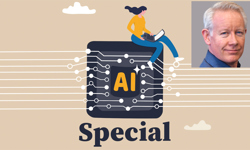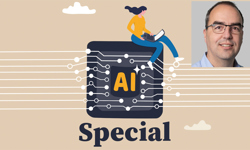“We know that print is a mature market with overall global demand for newsprint in decline,” says Anu Ahola, senior vice president, news & retail, UPM Paper ENA (Europe & North America). “But the picture is mixed. Developing countries like India are seeing print growth, whilst, even in the western European context, countries like Germany and Austria are seeing only moderate declines with national and regional newspaper sales holding up well.”
UPM has invested heavily in its business intelligence capabilities keeping a close eye on supply and demand. Over ten years ago, seeing the writing on the wall, the company took the strategic decision to diversify. New business units were created as the company moved into areas such as bio-fuels, bio-composites and CO2-free energy. Currently, UPM has a turnover of EUR 10 billion and the company consists of six separate business areas: Biorefining, Energy, Plywood, Raflatac (self-adhesive labels), Paper Asia and Paper ENA. Such has been the success of this transformation strategy that graphic papers for mature markets, which previously accounted for over 90% of revenues, now accounts for about 50%.
“What this means for our paper customers,” says Anu, “is that UPM is a financially solid supplier, whose diverse and growing operations mean that it is well placed to weather any short term turbulence in the graphic papers market – a market which the company is fully committed to.”
UPM is the largest supplier of newsprint to the European market, supplying over two million tons from its network of six European newsprint mills, which includes Shotton in the UK. The company’s UK client base includes national and regional newspaper publishers and printers. (UPM is also a major supplier of coated magazine papers (LWC) to the UK magazine sector, from its UPM Caledonian Paper mill near Glasgow, but this article is focusing on newsprint…)
Given the medium term trends in the newspaper market of declining print sales, and growing but under-performing digital revenues, publishers would appear to have two choices: manage a declining print market, focusing predominantly on taking costs out of the business and maximising short term revenue, or, investing in their print products thereby extending their life-cycle, increasing medium and long term revenues and pinning their colours firmly to a multi-platform publishing world with a clearly defined role for print.
Perhaps unsurprisingly, Anu is a firm advocate of the latter option. From her perspective, Anu is keen to draw publishers’ attention to eight key aspects of the print / digital debate:
1. Enduring appeal of print
We all know the strengths of digital (immediacy, multimedia, interactivity) but, as an industry, do we trumpet the undoubted strengths of print often enough? And, if publishers are uncertain about the core attributes of one of their main products, how can they optimise the value proposition?
UPM has invested heavily in research into this area. Amongst its main findings are:
* Print is a more trusted medium; exactly the same sentence when reproduced in print and digitally, is more trusted when it appears in print.
*Long form journalism and analysis works better in print as evidence suggests that complex concepts are easier to digest in print than from a screen.
* Print is a relaxed, pleasurable, lean-back experience.
* Print is uninterruptable and immune to both connectivity problems and the threat of ad-blockers. Print’s user interface is simple and unstressed!
* Print is based on renewable and recyclable material.
None of this is new or very surprising, but sometimes the industry lacks the confidence to state the obvious.
“The industry should not be apologising for print, but celebrating it”, insists Anu.
2. Quality journalism is the unique selling point
One of the most significant of a number of far-reaching macro-trends affecting the media business is the emergence of the sharing economy driven by the popularity of social media. As content gets distributed and shared ever more widely, its origins blur and ownership gets diluted, to the point where content becomes commoditised. Without clear branding and transparent content ownership, the distinctions between traditional publishers’ quality content and that produced by low grade content farms gets lost, and the publisher is the loser. Once all content is seen as having equal value, then publishers’ principal USP is well and truly lost.
What separates traditional newspaper (and magazine for that matter) publishers from much of their pure-play digital competition is the quality of the content.
If publishers see being first and being shared as their primary objectives, then they will find themselves in a self-fulfilling race to the bottom and, once there, their hitherto robust reputation for quality journalism will count for little.
“Quality is publishers’ USP and if they give that up too easily, they will find themselves caught in an unforgiving downward spiral.”
3. Innovation is a must
Innovation is not the preserve of the digital world and publishers should be alert to its potential in print. Any product, however mature, needs innovation and fresh thinking to breathe new life into it and to excite users. Innovation is one area which UPM likes to work closely with its publishing partners to foster new ideas, and, says Anu, print innovation is strong in the UK.
For the past couple of years, UPM has sponsored the Printed Innovation of the Year award at the newsawards, won in 2015 by the Newbury Weekly News, for its augmented reality 3D project and this year by DC Thomson for its hybrid print initiative. Recent investment by DC Thomson in a
digital print head has given the publisher the ability to create bespoke newspapers capable of carrying personalised content. Initially, this might simply be unique codes on lottery cards, but the technology has the potential to be expanded into the provision of more targeted news in print.
4. Continuous cost efficiency
With sales in long term decline, tight cost control is imperative and this is another area in which UPM likes to work closely with its clients. Driven by publisher demand, UPM is currently researching the efficacy of using lower grade papers and is testing the quality and runability of 40 gsm paper (the current UK standard weight is 42.5 gsm). Another area, says Anu, which UPM is investing much resource is in developing a new paper grade, which will be suitable for the production of retail marketing materials on cold-set presses. The thinking is to improve the productivity of publishers’ presses, by running third party print jobs during down times. More about the new grade will be heard at World Publishing Expo, where UPM is exhibiting again.
5. Paper is not a pure commodity
There are, says Anu, based on a third party analysis of publishers, three main criteria for paper supply: quality, availability and price. Choosing the right supplier involves balancing the three.
Security of supply is a key issue for time-sensitive newspaper publishers and there is much market volatility. Last year, Aylesford Newsprint in the UK went out of business; earlier this year, Holmen sold its Madrid newsprint mill and the new owners are converting it to containerboard production; similarly, Norske is planning to switch newsprint production at its Bruck mill in Austria to tissue production. UPM also sold its Schwedt mill in Germany to be converted to liner board. After this deal, UPM still has vast newsprint operations with six mills in five countries (Germany, UK, Austria, France and Finland) across Europe and can continue to ensure optimum reliability of supply, says Anu.
“Our aim is to be the ‘preferred supplier’ to our newsprint customers, working in long-term partnership with them, not just from one negotiating cycle to the next…”
6. Print’s green credentials need emphasising
Print, as an industry, allowed certain environmental misconceptions to take hold early on, says Anu, with the result that in the public eye, digital is seen as environmentally friendly whilst print is not.
The reality is a lot more complex and multi-faceted than that.
Paper is both renewable and recyclable, a fact Anu contrasts with e-waste which, according to recent Greenpeace research, can be toxic and very difficult to recycle.
The print industry in general has invested heavily in sustainability. One of UPM’s latest investments at its Shotton mill on Deeside is a power plant which will increase the mill’s renewable energy consumption to 70%. The new turbine will reduce the mill’s carbon footprint by approximately 27%.
In terms of CO2 emissions, continues Anu, those produced in creating a 200g newspaper from forest to reader (an example from Finland) are roughly the equivalent of those produced driving one kilometre in a car!
There are various industry initiatives attempting to set the record straight, and, suggests Anu, the industry as a whole should redouble its efforts to counter the perception that print is environmentally unfriendly.
7. Look to other markets for inspiration
It’s always a good idea to keep a close eye on other countries to see what we can learn from them. Germany, Austria and Finland are examples of European markets where sales of print newspapers are robust and, believes Anu, “print will be seen as a trusted source in these countries for many years to come”. While there are numerous structural differences between these markets and the UK market, not to mention underlying cultural and consumer behaviour differences, there might be things UK publishers can learn from their experiences, and, of course, vice versa!
8. Crucial role of digital!
The challenge all publishers face, says Anu, is knowing their customers (both readers and advertisers) and the technological trends then marrying the two into a compelling fit-for-purpose channel mix. It’s all about playing to the unique strengths of each platform. Twenty years ago, the media world was dominated by print and TV; the challenge now is not to replace print with digital, but instead to move to a genuinely multi-platform world where readers can benefit fully from the unique characteristics of each media: TV, radio, digital and print.
These are challenging times, concludes Anu, and publishers and suppliers need to work in partnership, helping each other to navigate through to a successful future. UPM is a rock-solid paper supplier, with a proven track record of innovation and a history of working with the newspaper industry. You are very welcome to get in touch with Anu and her team.
UPM Paper ENA
Georg-Haindl-Strasse, 86153 Augsburg, Germany
Anu Ahola, Senior Vice President, News & Retail
Tel: +358 (0) 204 15 111
Email: paperinfo@upm.com
UK Office: Peter Smith, Sales Director
Tel: 0870 600 0876
Email: peter.smith@upm.com










